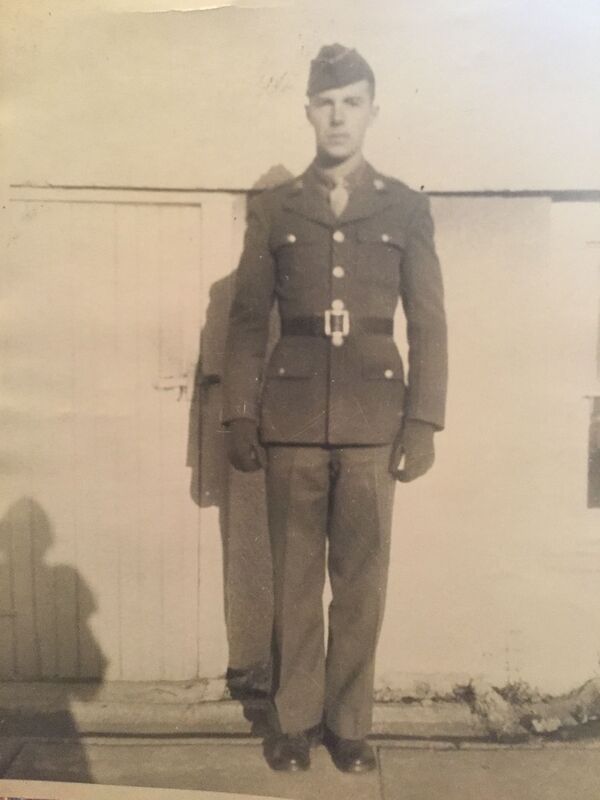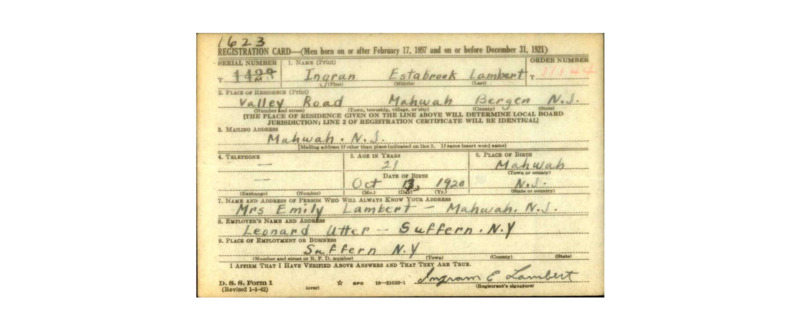Lambert, Ingram Estabrook
Item
Title
Lambert, Ingram Estabrook
Creator
Matthew Hyman
Cathy Moran Hajo
Contributor
Cole, Colleen
Birth Date
1920-10-13
Birthplace
Mahwah, NJ
Death Date
1944-06-06
Burial Place
Union Cemetery, Ramsey
Occupation
Delivery man
Conflict
Military Branch
Rank
Private First Class
Serial Number
42001422
Service Start Date
1943-07-23
Service End Date
1944-06-06
Honors
Rifleman Medal
Good Conduct Medal.
Purple Heart.
Presidential Citation.
Military Service Description
Ingram E. Lambert enlisted in the Army on July 1st, 1943 and underwent basic training at Camp Fannin, TX and Fort Meade, MD. He was shipped to Europe in January of 1944 and was killed on June 6th during the invasion of Normandy.
Biographical Text
Ingram E. Lambert was born in Mahwah in 1920. He attended the Darlington School and graduated from Ramsey High School. He attended Ramsey Sunday school. He worked as a deliveryman for Hilltop Bakery in Mahwah and for Leonard Utter in Suffern.
*Account by Colleen Cole, cousin of Pvt. Ingram E. Lambert:
An only child and unmarried with no children, Pvt. Ingram E. Lambert
from Mahwah was an American hero. He attended Mahwah schools (including
Darlington Schoolhouse) and Ramsey High School. Prior to enlistment, he
was a delivery driver for Hilltop Bakery in Mahwah.
Ingram was part of the 116th regiment of the 29th Division, C Company.
Their mission was to secure a section of Omaha Beach code named Dog
White. Ingram was the first soldier off Omaha Beach, and was hit by
machine gun fire while planting a land bomb called a Bangalore torpedo
to destroy barbed wire on the beach, but he died before he could ignite
the fuse. The fuse was later lit and Ingram’s fellow soldiers poured
through the enemy’s defenses. He was posthumously awarded the Bronze
Star and Purple Heart, among other awards and decorations in 2023. 
Here is the account of the scene and Ingram’s heroism from Omaha Beach.
The efforts of these men have been memorialized in the movie ”Saving
Private Ryan”.
”Omaha Beach June 6, 1944: Company C’s movement began about 0750. Across
the promenade road that edged the sea wall was a double-apron wire
entanglement. Pvt. Ingram E. Lambert jumped over the wall, crossed the
road, and set a bangalore torpedo. When he pulled the friction igniter,
it failed to act and Lambert was killed by a machine-gun bullet. The
platoon leader, 2d Lt. Stanley M. Schwartz, went over and fixed the igniter.
The explosive blew a large gap. The first man to try it was shot down;
others followed and took shelter in some empty trenches just beyond the
road, where they were joined by another group that had got through the
barrier by cutting the wire. After a delay of 5 to 10 minutes, while
more troops crossed the road to the trenches, they started again toward
the bluff, finding minor concealment from light enemy fire in the tall
grass and occasional bushes. Once they were on the hillside, the
defilade and smoke gave good protection, but progress was slowed by fear
of mines. The men went up in a narrow column, searching the ground
before them as they climbed and angling west to take advantage of a
faint path. No enemy were found in trenches along the crest. The column
went a couple of hundred yards into flat, open fields and stopped as it
met scattered fire from machine guns at some distance to the flanks.
This was the only sign of enemy resistance, and Company C had taken only
half-a-dozen casualties after leaving the sea wall. Capt. Berthier B.
Hawks, who had suffered a crushed foot in debarking, got to the top with
his men.
The 5th Ranger Battalion joined the advance very soon after it started,
and some of the Rangers were intermingled with Company C as they went
forward. The battalion had reached the sea wall just before 0800, in
platoon formations. Hasty preparations were made for assault, and
Colonel Schneider passed the word "Tallyho" to his officers, this being
the order for each platoon to make its own way beyond the bluffs to the
assembly area south of Vierville. About 0810 the Rangers began to cross
the road; what with the confusion at the beach and the smoke ahead, few
of them realized that Company C was already on the move in the same one.
Four gaps were blown in the wire with bangalores and the men went across
the beach flat at the double, then slowed to a crawl on the steep
hillside. Heavy smoke covered them on the climb, forcing some men to put
on gas masks. By the time the crest was reached, platoon formations were
disorganized and contacts lost. Just over the bluff top, German warning
signs enabled the Rangers to avoid a minefield from which engineers
later took 150 mines. The first groups up, a platoon of Company A and
some men of Company E, went straight on inland and disappeared. The
other platoons were on top by 0830 and stopped to reorganize. On the
left flank of the battalion, Company D’s platoons had to clean out a few
Germans from a trench system along the bluff edge, knocking out a
machine gun sited just below the crest and firing along the beach. The
battalion had lost only eight men, to small-arms fire that became more
ineffective as the movement progressed across the beach flat.”
An only child and unmarried with no children, Pvt. Ingram E. Lambert
from Mahwah was an American hero. He attended Mahwah schools (including
Darlington Schoolhouse) and Ramsey High School. Prior to enlistment, he
was a delivery driver for Hilltop Bakery in Mahwah.
Ingram was part of the 116th regiment of the 29th Division, C Company.
Their mission was to secure a section of Omaha Beach code named Dog
White. Ingram was the first soldier off Omaha Beach, and was hit by
machine gun fire while planting a land bomb called a Bangalore torpedo
to destroy barbed wire on the beach, but he died before he could ignite
the fuse. The fuse was later lit and Ingram’s fellow soldiers poured
through the enemy’s defenses. He was posthumously awarded the Bronze
Star and Purple Heart, among other awards and decorations in 2023. 
Here is the account of the scene and Ingram’s heroism from Omaha Beach.
The efforts of these men have been memorialized in the movie ”Saving
Private Ryan”.
”Omaha Beach June 6, 1944: Company C’s movement began about 0750. Across
the promenade road that edged the sea wall was a double-apron wire
entanglement. Pvt. Ingram E. Lambert jumped over the wall, crossed the
road, and set a bangalore torpedo. When he pulled the friction igniter,
it failed to act and Lambert was killed by a machine-gun bullet. The
platoon leader, 2d Lt. Stanley M. Schwartz, went over and fixed the igniter.
The explosive blew a large gap. The first man to try it was shot down;
others followed and took shelter in some empty trenches just beyond the
road, where they were joined by another group that had got through the
barrier by cutting the wire. After a delay of 5 to 10 minutes, while
more troops crossed the road to the trenches, they started again toward
the bluff, finding minor concealment from light enemy fire in the tall
grass and occasional bushes. Once they were on the hillside, the
defilade and smoke gave good protection, but progress was slowed by fear
of mines. The men went up in a narrow column, searching the ground
before them as they climbed and angling west to take advantage of a
faint path. No enemy were found in trenches along the crest. The column
went a couple of hundred yards into flat, open fields and stopped as it
met scattered fire from machine guns at some distance to the flanks.
This was the only sign of enemy resistance, and Company C had taken only
half-a-dozen casualties after leaving the sea wall. Capt. Berthier B.
Hawks, who had suffered a crushed foot in debarking, got to the top with
his men.
The 5th Ranger Battalion joined the advance very soon after it started,
and some of the Rangers were intermingled with Company C as they went
forward. The battalion had reached the sea wall just before 0800, in
platoon formations. Hasty preparations were made for assault, and
Colonel Schneider passed the word "Tallyho" to his officers, this being
the order for each platoon to make its own way beyond the bluffs to the
assembly area south of Vierville. About 0810 the Rangers began to cross
the road; what with the confusion at the beach and the smoke ahead, few
of them realized that Company C was already on the move in the same one.
Four gaps were blown in the wire with bangalores and the men went across
the beach flat at the double, then slowed to a crawl on the steep
hillside. Heavy smoke covered them on the climb, forcing some men to put
on gas masks. By the time the crest was reached, platoon formations were
disorganized and contacts lost. Just over the bluff top, German warning
signs enabled the Rangers to avoid a minefield from which engineers
later took 150 mines. The first groups up, a platoon of Company A and
some men of Company E, went straight on inland and disappeared. The
other platoons were on top by 0830 and stopped to reorganize. On the
left flank of the battalion, Company D’s platoons had to clean out a few
Germans from a trench system along the bluff edge, knocking out a
machine gun sited just below the crest and firing along the beach. The
battalion had lost only eight men, to small-arms fire that became more
ineffective as the movement progressed across the beach flat.”
Family Members
Ingram E. Lambert's parents were Lorenzo Lambert and Emily Estabrook.
Cole, Colleen Kennedy- first cousin, twice removed
Bibliography
Memorial Day Parade Program, May 25, 1988 (Lee Vold Collection, Mahwah Museum)
Ingran Estabrook Lambert, U.S., World War II Draft Cards Young Men, 1940-1947
Ingram Lambert's Service Sunday, Hackensack Record, December 18, 1947, p. 2.
Ingram E Lambert, U.S., Headstone Applications for Military Veterans, 1925-1970
Body of PFC Ingram Lambert, Mahwah, Scheduled to Arrive Next Thursday, Ridgewood Sunday News, December 14, 1947, p. 45.
Mahwah Soldier Dies on D-Day, Ridgewood Sunday News, July 23, 1944, p. 1.
Collection
Citation
Matthew Hyman and Cathy Moran Hajo, “Lambert, Ingram Estabrook,” Mahwah Veterans Project, accessed July 2, 2024, https://mahwahmuseum.reclaim.hosting/MVP/items/show/314.

